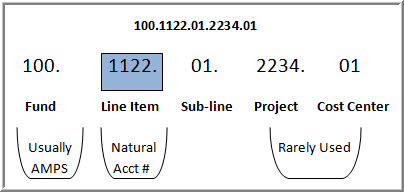
General Ledger account numbers can have up to five segments, or parts, composed of numbers and/or letters. The segments may be divided by a period, slash, dash, or tilde with no spaces between them.

In the account number above, you see the typical segment order and the sizes of each. However, the arrangement of account numbers can vary depending on how the agency wants to define them. The first two segments are the only required segments.
Fund segments represent money set aside for a specific project. Housing authorities typically use the fund segment to define their AMPs, Central Office Cost Center and S8.
Line item segments are the main part of the account. This segment typically corresponds to a HUD account as published in HUD Guidebook 7510:1 Public and Indian Housing Low-Rent Technical Accounting Guide. Many housing authorities use this numbering scheme established by HUD , but it is not required. The line item segment designates the specific type of revenue, expense, asset, liability or equity that posts to the account. If following the HUD guidelines, you should see the numbering pattern below for your line item segments. For example, tenant accounts receivable is an asset and its line item segment is defined as 1122.
| 1000 = | Asset Accounts |
| 2000 = | Liability and Surplus Accounts |
| 3000 = | Income Accounts |
| 4000 = | Expense Accounts |
| 5000 = | Credits/Charges on Long Term Debt |
| 6000 = | Credits/Charges Affecting Surplus |
| 7000 = | Memorandum Accounts |
| 8000 = | HUD Annual Contributions |
| 8100 = | Homeowner Payments |
Sub-line item segments divide the line items into more detailed sub-components. For each line item, you can define an unlimited number of sub-line items.
Project segments are optional in the account number. If a housing authority uses this segment, they must maintain one project record for each of their agency’s projects.
Cost Center segments are used by most authorities to define departments. This segment is rarely used.
Copyright © Tenmast Software 2011